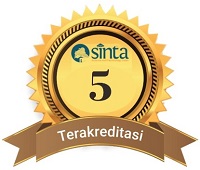OPTIMALISASI INDERA PERABA DAN PENDENGARAN DALAM PENGUASAAN ONE-HANDED OVERARM THROW ANAK DENGAN GANGGUAN PENGLIHATAN
Abstract
Keywords
Full Text:
PDFReferences
Aggius-Vella, E., Campus, C., Finocchietti, S., & Gori, M. (2017). Audio motor training at the foot level improves space representation. Frontiers in Integrative Neuroscience, 11. https://doi.org/10.3389/fnint.2017.00036
Bremner, A. J., & Spence, C. (2017). The Development of Tactile Perception. In Advances in Child Development and Behavior (Vol. 52, pp. 227-268). Academic Press Inc. https://doi.org/10.1016/bs.acdb.2016.12.002
Burhaein, E. (2017). Aktivitas Fisik Olahraga untuk Pertumbuhan dan Perkembangan Siswa SD. Indonesian Journal of Primary Education, 1(1), 51. https://doi.org/10.17509/ijpe.v1i1.7497
Campbell, S., Greenwood, M., Prior, S., Shearer, T., Walkem, K., Young, S., Bywaters, D., & Walker, K. (2020). Purposive sampling: complex or simple? Research case examples. Journal of Research in Nursing, 25(8), 652-661. https://doi.org/10.1177/1744987120927206
Creswell, J. W., & Creswell, J. D. (2018). Research Design: Qualitative, Quantitative adn Mixed Methods Approaches (5th Ed.). SAGE Publications Sage CA: Los Angeles, CA.
Cuppone, A. V., Cappagli, G., & Gori, M. (2019). Audio-Motor Training Enhances Auditory and Proprioceptive Functions in the Blind Adult. Frontiers in Neuroscience, 13. https://doi.org/10.3389/fnins.2019.01272
Darvishi, S., Gharabaghi, A., Boulay, C. B., Ridding, M. C., Abbott, D., & Baumert, M. (2017). Proprioceptive feedback facilitates motor imagery-related operant learning of sensorimotor ß-band modulation. Frontiers in Neuroscience, 11(FEB). https://doi.org/10.3389/fnins.2017.00060
Deci, E. L., & Ryan, R. M. (2015). Self-Determination Theory. In International Encyclopedia of the Social & Behavioral Sciences: Second Edition (pp. 486-491). Elsevier Inc. https://doi.org/10.1016/B978-0-08-097086-8.26036-4
Ericsson, K., Hoffman, R., Kozbelt, A., & Williams, A. (2018). The Cambridge Handbook of Expertise and Expert Performance (K. Ericsson, R. Hoffman, & A. Kozbelt, Eds.; 2nd Ed). Cambridge University Press.
Finocchietti, S., Cappgli, G., Porquis, L. ben, Baud-Bovy, G., Cocchi, E., & Gori, M. (2015). Evaluation of the Audio Bracelet for Blind Interaction for improving mobility and spatial cognition in early blind children - A pilot study. 2015 37th Annual International Conference of the IEEE Engineering in Medicine and Biology Society (EMBC). https://doi.org/https://doi.org/10.1109/EMBC.2015.7320248
Guyton and Hall J. E. (2012). Guyton and Hall Textbook of Medical Physiology. 12 ed.
Haibach, P. S., Wagner, M. O., & Lieberman, L. J. (2014). Determinants of gross motor skill performance in children with visual impairments. Research in Developmental Disabilities, 35(10), 2577-2584. https://doi.org/10.1016/j.ridd.2014.05.030
Iswana, B. (2019). Model of Exercise Imagery For Supports The Success of Kick, Bearing and Scissor Techniques. Jambura Journal of Sports Coaching, 1(1).
Johnson, J. L., Rudisill, M. E., Hastie, P. A., & Sassi, J. (2018). The Influence of Guided Practice on Overhand Throwing Competence in Preschool Children in a Mastery Motivational Climate. Journal of Motor Learning and Development, 7(1), 64-83. https://doi.org/10.1123/jmld.2018-0005
Lieberman, L. J., Haegele, J. A., Columna, L., & Conroy, P. (2014). How students with visual impairments can learn components of the expanded core curriculum through physical education. Journal of Visual Impairment and Blindness, 108(3), 239-248. https://doi.org/10.1177/0145482x1410800307
Loprinzi, P. D., Davis, R. E., & Fu, Y. C. (2015). Early motor skill competence as a mediator of child and adult physical activity. In Preventive Medicine Reports (Vol. 2, pp. 833-838). Elsevier Inc. https://doi.org/10.1016/j.pmedr.2015.09.015
Marshall, C., & Rossman, G. B. (2016). Designing Qualitative Research (Sixth Ed.). SAGE Publications, Inc.
Mayes, M., Salesky, M., & Lansdown, D. A. (2022). Throwing Injury Prevention Strategies with a Whole Kinetic Chain-Focused Approach. Current Reviews in Musculoskeletal Medicine, 15(2), 53-64. https://doi.org/10.1007/s12178-022-09744-9
Mosston, M., & Ashworth, S. (2008). Teaching Physical Education (S. Ashworth, Ed.; 1st Online). Pearson Education.
Musheke, M. M., & Phiri, J. (2021). The Effects of Effective Communication on Organizational Performance Based on the Systems Theory. Open Journal of Business and Management, 09(02), 659-671. https://doi.org/10.4236/ojbm.2021.92034
O' Dowd, A., Cooney, S. M., & Newell, F. N. (2022). Self-reported vividness of tactile imagery for object properties and body regions: An exploratory study. Consciousness and Cognition, 103. https://doi.org/10.1016/j.concog.2022.103376
Richard, G., Pietrzak, T., Argelaguet, F., Lécuyer, A., & Casiez, G. (2021). Studying the Role of Haptic Feedback on Virtual Embodiment in a Drawing Task. Frontiers in Virtual Reality, 1. https://doi.org/10.3389/frvir.2020.573167
Romas, J. A., & Sharma, M. (2017). Effective Communication. In Practical Stress Management (pp. 69-89). Elsevier. https://doi.org/10.1016/B978-0-12-811295-3.00004-8
Tyng, C. M., Amin, H. U., Saad, M. N. M., & Malik, A. S. (2017). The influences of emotion on learning and memory. In Frontiers in Psychology (Vol. 8, Issue AUG). Frontiers Media S.A. https://doi.org/10.3389/fpsyg.2017.01454
Yin, R. K. (2018). Case Study Research and Applications: Design and Methods (6th Ed.). SAGE Publications, Inc.
Zheng, Y., Ye, W., Korivi, M., Liu, Y., & Hong, F. (2022). Gender Differences in Fundamental Motor Skills Proficiency in Children Aged 3-6 Years: A Systematic Review and Meta"Analysis. In International Journal of Environmental Research and Public Health (Vol. 19, Issue 14). MDPI. https://doi.org/10.3390/ijerph19148318
DOI: https://doi.org/10.37311/jjsc.v5i1.17719
Refbacks
- There are currently no refbacks.

Jambura Journal of Sports Coaching (p-ISSN: 2654-3435 | e-ISSN: 2656-0437) is licensed under a Creative Commons Attribution-ShareAlike 4.0 International License.
Jambura Journal of Sports Coaching has been indexed by:
-------------------------------------------------- -------------------------------------------------- -------------------------------------------------- -----------------------------
-------------------------------------------------- -------------------------------------------------- -------------------------------------------------- -----------------------------
BERKOLABORASI DENGAN
















_-_Copy.jpg)